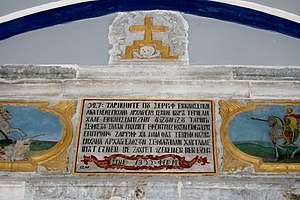Karamanli Turkish
Karamanlı Turkish (Turkish: Karamanlı Türkçesi, Greek: Καραμανλήδικα, romanized: Karamanlídika), is both a form of written Turkish and a dialect of Turkish spoken by the Karamanlides, a community of Turkish-speaking Orthodox Christians in Ottoman Turkey. While the official Ottoman Turkish was written in the Arabic script, the Karamanlides used the Greek alphabet for writing their form of Turkish. Karamanlı Turkish had its own literary tradition and produced numerous published works in print in the 19th century, some of them published by Evangelinos Misailidis, by the Anatoli or Misailidis publishing house (Misailidis 1986, p. 134).
| Karamanlı Turkish | |
|---|---|
| Karamanlıca - Karamanlı Türkçesi | |
| Native to | Greece, Bulgaria, North Macedonia, Romania, Turkey |
| Era | 19th century; possibly maintained in the diaspora |
| Greek | |
| Language codes | |
| ISO 639-3 | – |
| Glottolog | kara1469[1] |
Karamanlı writers and speakers were expelled from Turkey as part of the Greek-Turkish population exchange of 1923. Some speakers preserved their language in the diaspora. The writing form stopped being used immediately after the Turkish state adopted the Latin alphabet.
A fragment of a manuscript written in Karamanlı was also found in the Cairo Geniza.[2]
Media
There was a Karamanli Turkish newspaper, Anatoli, published from 1850 to 1922,[3] made by Evangelinos Misalaidis. Other publications in Karamanli were Anatol Ahteri, Angeliaforos, Angeliaforos coçuklar içun, Şafak, and Terakki. The second and third were created by the American Board of Commissioners for Foreign Missions. Demetrius Nicolaides also applied to make his own Karamanli publication, Asya ("Asia"), but was denied; he instead made an Ottoman Turkish newspaper called Servet. Evangelina Baltia and Ayșe Kavak, authors of "Publisher of the newspaper Konstantinoupolis for half a century," wrote that they could find no information explaining why Nicolaides' proposal was turned down.[4]
Further reading
- Evangelia Balta, Karamanlı Yazınsal Mirasının Ocaklarında Madencilik, 2019, Yapı Kredi Yayınları. (in Turkish)
- —, 19. Yüzyıl Osmanlıca ve Karamanlıca Yayınlarda Ezop’un Hayatı ve Masalları (prep.), 2019, Libra Kitap.
- —, Karamanlıca Kitaplar Çözümlemeli Bibliyografya Cilt I: 1718-1839 (Karamanlıdıka Bibliographie Analytique Tome I: 1718-1839), 2018, Türkiye İş Bankası Kültür Yayınları.
- —, Gerçi Rum İsek de, Rumca Bilmez Türkçe Sözleriz: Karamanlılar ve Karamanlıca Edebiyat Üzerine Araştırmalar, 2012, Türkiye İş Bankası Kültür Yayınları.
References
- Hammarström, Harald; Forkel, Robert; Haspelmath, Martin, eds. (2017). "Karamanli". Glottolog 3.0. Jena, Germany: Max Planck Institute for the Science of Human History.
- Julia Krivoruchko Karamanli – a new language variety in the Genizah: T-S AS 215.255 http://www.lib.cam.ac.uk/Taylor-Schechter/fotm/july-2012/index.html Archived 2016-10-27 at the Wayback Machine
- Michael, Michalis N.; Börte Sagaster; Theoharis Stavrides (2018-02-28). "Introduction". In Sagaster, Börte; Theoharis Stavrides; Birgitt Hoffmann (eds.). Press and Mass Communication in the Middle East: Festschrift for Martin Strohmeier. University of Bamberg Press. pp. v-. ISBN 9783863095277. Cited: p. xi
- Balta, Evangelia; Ayșe Kavak (2018-02-28). Sagaster, Börte; Theoharis Stavrides; Birgitt Hoffmann (eds.). Publisher of the newspaper Konstantinoupolis for half a century. Following the trail of Dimitris Nikolaidis in the Ottoman archives. Press and Mass Communication in the Middle East: Festschrift for Martin Strohmeier. University of Bamberg Press. pp. 33-. ISBN 9783863095277. // Cited: p. 42
